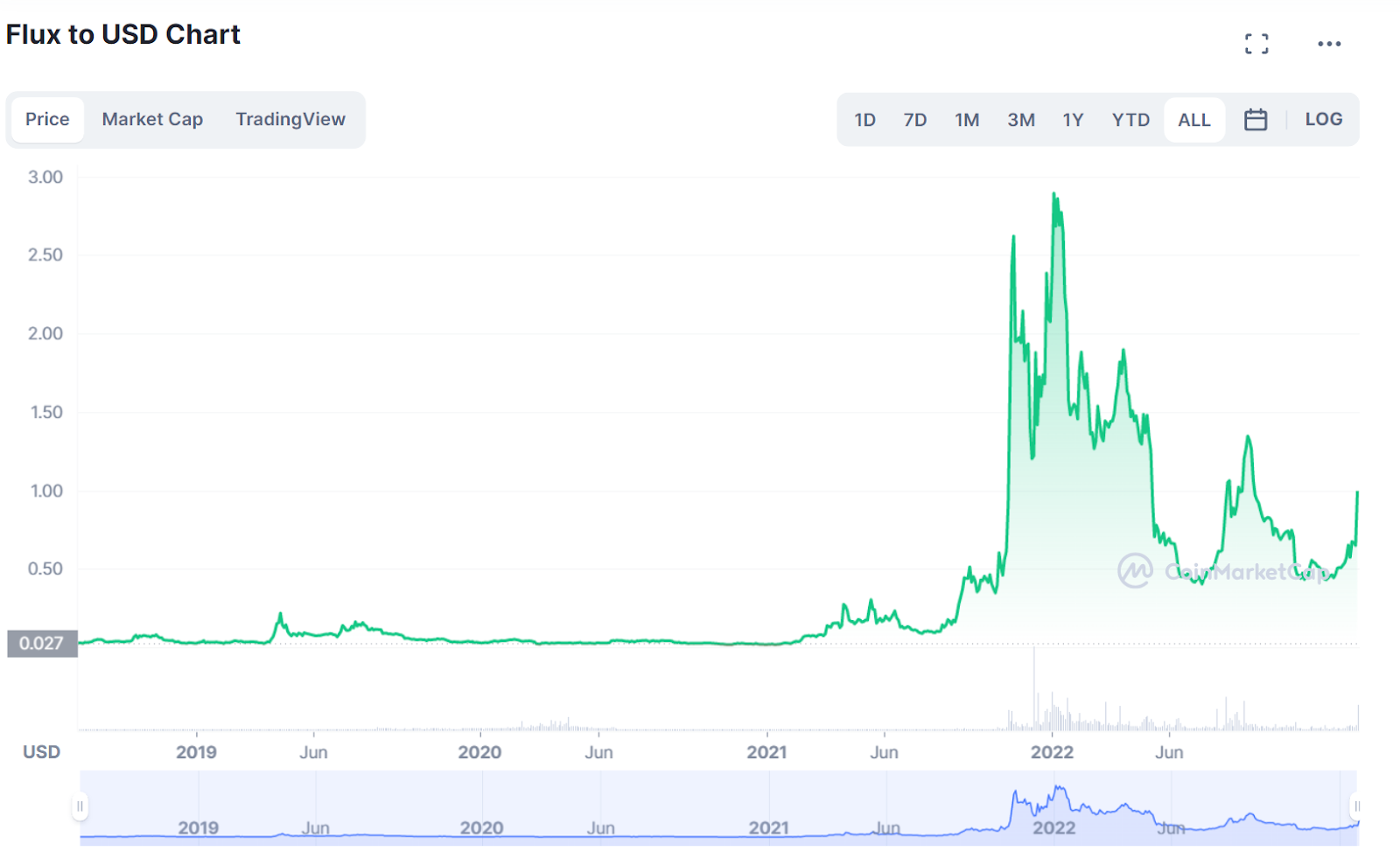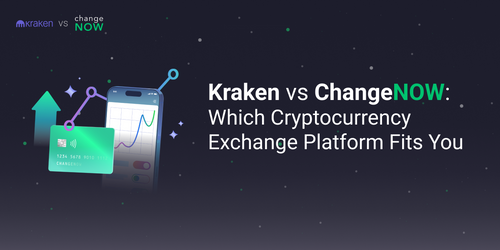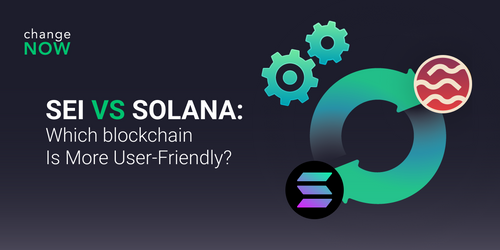Flux (FLUX) Review 2023
With over 4000 dApps currently hosted on the network, Flux is rapidly becoming the preferred platform for decentralized projects. It offers a secure, scalable, interoperable, and reliable environment that is also censorship-resistant and cost-effective for developers. Some of the network's success can be attributed to its active partnerships with other blockchain projects. Let's delve deeper into the Flux ecosystem and the opportunities it presents for developers.

About Flux (FLUX)
The primary goal of the Flux ecosystem is to provide ease of access to the Web3 space. With more than 15,000 functional nodes it is the largest decentralized network globally. Flux is also the most affordable cloud provider available with deployment costs up to 10 times lower than centralized providers like AWS or Google Cloud.
Disrupting Centralized Structures
Flux’s main feature is its decentralization, as stated earlier, its core values center around promoting a truly decentralized Web 3.0. Flux was created to address the issue of centralized control of data by a few powerful companies.
Flux allows node operators to run their own nodes on personal hardware or a virtual private server. The platform also offers community node providers like Hostnodes and GoldieTech for those who want a home-hosted option. In return, they are rewarded for their contributions, with 50% of the total block reward going back to the community.
Being truly decentralized ensures the network does not have a single point of failure. In addition to the absence of a single pressure point, Flux users also get to enjoy 100% uptime.
Flux is powered by the utility token FLUX which serves a series of purposes on the platform. It can be used to purchase resources, collateralize nodes, and fuel transactions on Flux’s second-layer operating system FluxOS. FLUX is also used to reward both miners and node operators for providing computational resources. The platform offers other ways to earn rewards such as airdrops, and mining on the main and parallel chains with a 1:10 ratio. Community engagement on Discord can also yield returns.
Flux (FLUX) Team
According to the Flux website, the team is a decentralized group of volunteers and leaders committed to the platform’s core goal. The Flux network has 3 co-founders each of whom brings their own unique skills and experience to the project.
At the helm of the team is Co-Founder and Chief Strategy Officer, Daniel Keller. With over 25 years of experience in technology infrastructure, operations, and large-scale project leadership, Keller brings a wealth of knowledge to the Flux team.
Co-Founder number 2 Tadeas Kmenta has been an integral part of the Flux project since its inception. As the Chief Innovations Officer, he is focused on the emergence and development of new solutions within Flux and FluxOS.
Meanwhile, Parker Honeyman, the third Co-Founder of Flux, functions as Chief Operations Officer and Engineer. Honeyman brings a combination of technical know-how and proven development processes to the project.
Flux (FLUX) Roadmap
Flux has been in development for the past 3 years. As such the timeline for the official Flux roadmap covers the years 2020 to 2023. In the roadmap, the Flux team outlines plans for each quarter of the respective years. The project is now in the first quarter of 2023 and core parts of the roadmap for this period include;
WordPress, Storage, and Jetpack 3.0: Flux is working on integrating WordPress with its decentralized storage solution, Jetpack 3.0, to provide a fully decentralized WordPress platform for users.
Fractus Cumulus Storage Nodes Rewards: Flux is introducing a rewards program for Fractus Cumulus storage nodes, incentivizing users to provide storage space to the network.
Decentralized WordPress for the Public: Flux will be making its decentralized WordPress platform available to the public, allowing anyone to create and host their WordPress site on the decentralized network.
FluxOS Mobile App v0.1.2: A new version of the FluxOS mobile app will be released, providing users with improved functionality such as the OS for the Flux Web3 Cloud backend, an easy management tool for all FluxNodes supporting the Flux Cloud - a dashboard, statistics and more, all adding up to a better user experience.
Fiat Payment For Flux Cloud Services: Flux will be introducing the ability for users to pay for its cloud services using fiat currency.
XDAO 2.0 Proposal to community: Flux will be proposing a new version of its XDAO governance model to the community for feedback and input.
Dynamic Pricing Structure: Flux will be implementing a dynamic pricing structure for its cloud services, allowing users to pay based on their usage.
Q2 - Q4 2023
Further down the year Flux also intends to host a Flux Hackathon to encourage developers to build on the ecosystem. The First Flux Conference is also in the works for Q2 of this year. The platform will put measures in place to reduce carbon footprint across online platforms. Notably, this is already one of Flux’s ongoing projects.
Flux is working on sustainable solutions for proof of work and cloud computing. They aim to use energy responsibly through active development and innovation in emerging technology and blockchain. The platform has implemented Proof-of-Useful-Work as a consensus method for a sustainable way of mining cryptocurrency. This approach uses computational power for solving real-world problems while securing the blockchain, resulting in less power and fewer carbon emissions. PoUW not only provides an alternative to crypto mining but also transforms the way we consume and use resources.
Q3 of this year will see Flux commence the proof-of-concept phase for its Proof of Useful Work consensus mechanism. In the final months of the year, the platform will launch its Flux University and also hold the Flux Hackathon 2.
Flux (FLUX) Network
Flux Chain
Flux is a multi-chain cloud infrastructure provider, utilizing its core blockchain and connections to seven other chains. These are, Ethereum (ETH), Binance Smart Chain (BSC), Kadena (KDA), Solana (SOL), Tron (TRX), Avalanche (AVAX), and Ergo (ERG), with plans to add three more in the future.
Flux Parallel Assets
Flux is gunning to become the leading network, a pioneer in the Web3 space. However, to do this an interoperable ecosystem is a necessity. Acknowledging this led the team to the concept of parallel assets. Before this Flux’s native FLUX coin was performing well but it was limited to the Flux blockchain.
With parallel assets, other blockchains can host Flux equivalents. Parallel assets work similarly to token bridges, enabling assets to be transferred between different blockchains. These assets are fully compatible with other networks while still bringing aboard Flux’s unique features. Flux’s parallel assets feature allows developers to easily run their applications on a variety of major blockchains. This opens up access to DeFi services and eliminates the risk of their applications being limited to just the Flux network.
Flux has launched several parallel assets on other blockchains, including Flux-Kadena, Flux-ETH, and Flux-BSC on Ethereum and Binance Smart Chain. In Q3 2021, Flux-Sol and Flux-Tron were also distributed. Flux-Avax was the first asset to be released in 2022, followed by the Flux-Ergo launch in the fall. There will be a total of ten parallel assets, seven of which have been deployed with three still to come.
Flux Ecosystem
As stated earlier, the Flux ecosystem is home to more than 4000 projects. Given the network’s ease of access and reliability, it is likely to see more adoption in the future. Here’s a list of the main components of the Flux ecosystem presently.
- FluxOS: FluxOS is an advanced second-layer operating system/application that allows developers to deploy hardened, dockerized apps on Flux's fully decentralized computational network. It also allows for the creation of parallel assets, which can be used to interact with other blockchains and access decentralized finance services.
- $FLUX: This is the native digital currency of the Flux ecosystem, which can be mined using a proof-of-work consensus mechanism.
- The Flux blockchain: is the foundation of the Flux ecosystem and is responsible for maintaining and verifying all transactions, smart contracts, and other data stored on the network. It also plays a vital role in the governance, economics, and parallel assets of the ecosystem.
- Zelcore: This is the primary digital asset platform in the Flux ecosystem. It includes a wallet called the Zelcore wallet and a built-in trading tool. Users can easily manage and trade their digital assets, including cryptocurrencies, tokens, and other digital assets, on various exchanges through its user-friendly interface. Zelcore supports a wide range of digital assets and provides advanced security features alongside several useful functions.
- The Flux Network (FluxNodes): A decentralized network for powering and running DApps on the Flux ecosystem. It uses a global network of nodes for live and operational DApps at all times, ensuring scalability and security. Network participants can interact with global apps, vote in the Flux network DAO and view resources and rewards.
FLUX Tokenomics
The total FLUX supply is 440 million units of which 94.7% is owned by users, and 2.9% is held by the Flux Foundation. The remaining 1.7% is allocated for exchange listing and liquidity, and 0.7% is held by the Flux team. The circulating supply is 257,367,586 FLUX; 106,254,000 FLUX of which is locked in Flux nodes.
There was no ICO/IEO/Pre-sale held for FLUX and the block reward for mining is split evenly between Proof of Work (POW) mining and FluxNode operators. The current reward rests at 37.5 FLUX per block. Node operators also receive rewards through a deterministic round-robin system, ensuring fair distribution. Additional rewards can be earned through parallel mining of Flux parallel assets, which doubles the block rewards.
How to Mine Flux (FLUX)
Since its inception Flux has been GPU mined. This is a crypto mining process that uses specialized graphics card cores to solve crypto puzzles and verify transaction blocks. FLUX can be mined on Fluxpools.net, which is the community pool, or on a variety of third-party pools that support the mining ecosystem. It's worth noting that there are pools that allow you to mine Flux parallel assets, which offer higher rewards.
In addition to traditional mining, there are other ways to earn FLUX within the Flux community. One way is to participate in the Flux Discord, where community members can earn FLUX through a variety of activities such as bug reporting and contributing to the development of the ecosystem. Users can also gain FLUX at first just by holding, as every time FLUX introduces a new parallel asset there is an airdrop of the new tokens to FLUX holders. Another viable option is to buy FLUX in a crypto exchange service.
FLUX Value Data
As of January 28, 2023 the FLUX coin price rests at $0.900454, roughly 42% above its 52-week low. Following its inception, FLUX traded at an average of $0.03 until late 2021 when its value began to climb. The token hit an all-time high of $4.17 in December of that year. This came amid the 2021 DeFi boom as FLUX saw an upward trend in demand for its features across the cryptocurrency market. The current circulating supply of FLUX is 288,319,894 coins and a max supply of 440,000,000 coins. The FLUX market cap is $260M, and the token is ranked 131st on CoinMarketCap.

Flux (FLUX) 2023 Price Prediction
FLUX has continued to trade steadily over the past year despite the volatile conditions of the crypto market. Price prediction platforms expect that FLUX will only climb further in the future.
According to DigitalCoinPrice, FLUX will see an average value of $1.94 in the course of this year. The platform sets the mean price for the FLUX coin at $2.32 with a peak value of $2.34. AMB Crypto forecasts even more bullish action for FLUX in the short term as the service expects the token to hit $3.39 by March 2023.
Where to Buy Flux (FLUX)
Flux is available for purchase on several top exchanges. These include Binance, Crypto.com, Gate.io, and more. Use non-custodial crypto exchange platform ChangeNOW to get FLUX instantly with no registration or hidden fees.
Flux (FLUX) Wallets
The Flux ecosystem features a digital wallet called the Zelcore wallet. It also offers users a built-in trading tool where they can easily manage and trade their assets.
Additionally, FLUX users can employ ChangeNow’s wallet offering to hold their FLUX coins. The non-custodial NOW Wallet is easy to use and prioritizes privacy giving users full control over their private keys. NOW Wallet supports over 400 cryptocurrencies including FLUX on various blockchains and allows users to trade token assets within the app. ChangeNow also offers the NowTracker, a free crypto portfolio tracking app that provides a comprehensive overview of your crypto portfolio.
Flux (FLUX) Crypto Exchanges
ChangeNOW presents a seamless and swift solution for swapping your cryptocurrency for FLUX coins. ChangeNOW supports mainnet FLUX, ERC20 FLUX, and BSC FLUX. Notably, the NOW Wallet supports FLUX on blockchain platforms Tron, Solana, and Avalanche. The exchange process is effortless and requires no registration, simply input the desired currencies and amounts. Following this drop your Flux address and deposit your chosen cryptocurrency. Our exchange platform operates with transparency, with all fees already factored into the displayed exchange rate. Experience a hassle-free purchase with ChangeNow.



